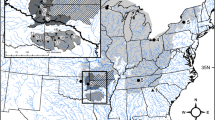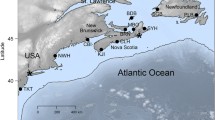Abstract
Because only 3–7% of historically present vernal pool habitat remains in coastal San Diego County, conservation efforts must prioritize both the maintenance of these pools and the genomic integrity of their inhabitants. Coastal vernal pools found in southern California are home to the federally endangered San Diego fairy shrimp Branchinecta sandiegonensis. Simovich et al. (J Crustac Biol 33:730–740, 2013) characterized hybridization between B. sandiegonensis and the versatile fairy shrimp (Branchinecta lindahli) using morphological characters, but these characters are only found in adult females. To detect adult female, male and juvenile hybrids in the wild, we developed a genomic hybrid index comprised of 20 SNP loci using 16 individuals with no morphological evidence of hybridization, collected from populations unlikely to facilitate introgression. These loci have alternatively fixed alleles between the two species. This genomic hybrid index was validated using 426 individuals from 27 localities using morphology and habitat information. Our data suggest that some artificial and disturbed pool basins harbor hybrids, and thus have the potential to be stepping-stones for the future spread of hybrids. This genomic hybrid index will be a useful tool for identifying putative Branchinecta hybrids from both mature and immature life history stages, and aid in the monitoring and recovery of non-admixed B. sandiegonensis.


Similar content being viewed by others
References
Altschul SF, Gish W, Miller W, Myers EW, Lipman DJ (1990). Basic local alignment search tool. J Mol Biol 215(3):403–410
Anderson E, Stebbins GL (1954) Hybridization as an evolutionary stimulus. Evolution 8(4):378–388
Anderson EC, Thompson EA (2002) A model-based method for identifying species hybrids using multilocus genetic data. Genetics 160:1217–1229
Arnold ML (2006) Evolution through genetic exchange. Oxford University Press, Oxford
Bajec SS, Pustovrh G, Jesenšek D, Snoj A (2015) Population genetic SNP analysis of marble and brown trout in a hybridization zone of the Adriatic watershed in Slovenia. Biol Conserv 184:239–250
Bauder ET, McMillan S (1998) Current distribution and historical extent of vernal pools in southern California and northern Baja California, Mexico In Ecology, Conservation, and Management of Vernal Pool Ecosystems. Proceedings from a 1996 Conference California Native Plant Society, Sacramento, California, pp 56–70
Bauder E, Bohonak AJ, Hecht B, Simovich MA, Shaw SD, Jenkins DG, Rains M (2009) A draft regional guidebook for applying the hydrogeomorphic approach to assessing wetland functions of vernal pool depressional wetlands in southern California. San Diego State University, San Diego
Belk D (1998) Global status and trends in ephemeral pool invertebrate conservation: implications for Californian fairy shrimp Witham, CW. In: Bauder ET (eds), Current distribution and historical extent of vernal pools in southern California and northern Baja California, Mexico in Ecology, Conservation, and Management of Vernal Pool Ecosystems. Proceedings from a 1996 Conference California Native Plant Society, Sacramento, California, pp 147–150
Bradić M, Costa J, Chelo IM (2011) Genotyping with sequenom. Mol Methods Evol Genet 772:193–210
Chomczynski P, Sacchi N (1987) Single-step method of RNA isolation by acid guanidinium thiocyanate-phenol-chloroform extraction. Anal Biochem 162:156–159
Devictor V, Julliard R, Clavel J, Jiguet F, Lee A, Couvet D (2008a) Functional biotic homogenization of bird communities in disturbed landscapes. Glob Ecol Biogeogr 17:252–261
Devictor V, Julliard R, Jiguet F (2008b) Distribution of specialist and generalist species along spatial gradients of habitat disturbance and fragmentation. Oikos 117:507–514
Edgar RC (2004) MUSCLE: multiple sequence alignment with high accuracy and high throughput. Nucleic Acids Res 32:1792–1797
Ellstrand NC, Schierenbeck KA (2000) Hybridization as a stimulus for the evolution of invasiveness in plants? Proc Natl Acad Sci 97(13):7043–7050
Erickson CH, Belk D (1999) Fairy shrimps of California’s puddles, pools, and playas. Mad River Press Inc., Eureka
Estoup A, Guillemaud T (2010) Reconstructing routes of invasion using genetic data: why, how and so what? Mol Ecol 19:4113–4130
Fugate M (1993) Branchinecta sandiegonensis, a new species of fairy shrimp (Crustacea: Anostroca) from Western North America. Proc Biol Soc Wash 106:296–304
Fugate M (1998) Branchinecta of North America: population structure and its implications for conservation practice. In: Ecology, conservation, and management of vernal pool ecosystems. California Native Plant Society, Sacramento, pp 140–146
Gompert Z, Buerkle C (2009) A powerful regression-based method for admixture mapping of isolation across the genome of hybrids. Mol Ecol 18:1207–1224
Gompert Z, Buerkle C (2010) INTROGRESS: a software package for mapping components of isolation in hybrids. Mol Ecol Resour 10:378–384
Grabherr MG, Haas BJ, Yassour M, Levin JZ, Thompson DA, Amit I, Chen Z (2011) Full-length transcriptome assembly from RNA-Seq data without a reference genome. Nat Biotechnol 29:644–652
Hedrick PW (2013) Adaptive introgression in animals: examples and comparison to new mutation and standing variation as sources of adaptive variation. Mol Ecol 22:4606–4618
King JL (1998) Loss of diversity as a consequence of habitat destruction in California vernal pools. In: Ecology, conservation, and management of vernal pool ecosystems. Proceedings from a 1996 Conference California Native Plant Society, Sacramento, pp 119–123
Konczal M, Koteja P, Stuglik MT, Radwan J, Babik W (2014) Accuracy of allele frequency estimation using pooled RNA-SEq. Mol Ecol Resour 14:381–392
Krueger F (2015) Trim Galore: a wrapper tool around Cutadapt and FastQC to consistently apply quality and adapter trimming to FastQ files. https://www.bioinformatics.babraham.ac.uk/projects/trim_galore/
Langmead B, Trapnell C, Pop M, Salzberg SL (2009) Ultrafast and memory-efficient alignment of short DNA sequences to the human genome. Genome Biol. https://doi.org/10.1186/gb-2009-10-3-r25
Larsson A (2014) AliView: a fast and lightweight alignment viewer and editor for large datasets. Bioinformatics 30:3276–3278
Li H, Handsaker B, Wysoker A, Fennell T, Ruan J, Homer N, Durbin R (2009) The sequence alignment/map format and SAMtools. Bioinformatics 25:2078–2079
Li C, Gowan S, Anil A, Beck BH, Thongda W, Kucuktas H, Peatman E (2015) Discovery and validation of gene-linked diagnostic SNP markers for assessing hybridization between Largemouth bass (Micropterus salmoides) and Florida bass (M floridanus). Mol Ecol Resour 15:395–404
Madison W, Madison D (2004) Mesquite: a modular system for evolutionary analysis Version 105 http://mesquiteproject.org
Mooney HA, Cleland EE (2001) The evolutionary impact of invasive species. Proc Natl Acad Sci 98(10):5446–5451
Olden JD, Poff NL, Douglas MR, Douglas ME, Fausch KD (2004) Ecological and evolutionary consequences of biotic homogenization. Trends Ecol Evol 19(1):18–24
Olden JD, Rooney TP (2006) On defining and quantifying biotic homogenization. Glob Ecol Biogeogr 15(2):113–120
Primmer CR, Borge T, Lindell J, Sætre GP (2002) Single-nucleotide polymorphism characterization in species with limited available sequence information: high nucleotide diversity revealed in the avian genome. Mol Ecol 11:603–612
Pritchard JK, Stephens M, Donnelly P (2000) Inference of population structure using multilocus genotype data. Genetics 155:945–959
Rhymer JM, Simberloff D (1996) Extinction by hybridization and introgression. Annu Rev Ecol Syst 27:83–109
Rogers DC (2002) Female-based characters for Anostracan (Crustacea: Branchiopoda) identification: a key for species of California and Oregon, USA. Hydrobiologia 486:125–132
Schmieder R, Edwards R (2011) Quality control and preprocessing of metagenomic datasets. Bioinformatics 27(6):863–864
Seehausen O (2004) Hybridization and adaptive radiation. Trends Ecol Evol 19:198–207
Simovich MA, Davis KB, Bohonak AJ (2013) Landscape homogenization threatens the genetic integrity of the endangered San Diego fairy shrimp Branchinecta sandiegonensis (Branchiopoda: Anostraca). J Crustac Biol 33:730–740
Team RC (2016) R: A language and environment for statistical computing. R Foundation for Statistical Computing, Vienna. http://www.R-project.org
US Fish and Wildlife Service (1997) Endangered and threatened wildlife and plants; determination of endangered status for the San Diego fairy shrimp Federal Register Number 97-2578, pp 4925–4939
VÄHÄ JP, Primmer CR (2006) Efficiency of model-based Bayesian methods for detecting hybrid individuals under different hybridization scenarios and with different numbers of loci. Mol Ecol 15:63–72
Waterkeyn A, Vanschoenwinkel B, Elsen S, Anton-Pardo M, Grillas P, Brendonck L (2010) Unintentional dispersal of aquatic invertebrates via footwear and motor vehicles in a Mediterranean wetland area aquatic conservation. Mar Freshw Ecosyst 20:580–587
Acknowledgements
The authors would like to thank Charles Black for help with sample collection and his insights on fairy shrimp biology. We thank David Carlson, Shahan Derkarabetian for their assistance in transcriptome assembly and SNP discovery as well as Cheryl Hayashi, William Walton and the anonymous reviewer for providing helpful suggestions regarding manuscript preparation. We also thank the genomic services laboratory at Hudson Alpha Institute for Biotechnology for help with sample preparation and technicians at the University of Arizona Genetics Core for help with multiplex optimization. Funding for this study was granted by the San Diego Association of Governments (SANDAG), U.S. Department of the Navy (Cooperative Agreement N62473-14-2-0001), California Department of Fish and Wildlife and U.S. Fish and Wildlife Service (Cooperative Endangered Species Conservation Fund/Section 6 Grant P1382012). All ‘‘take’’ was conducted under the supervision of Marie Simovich as authorized under US Fish and Wildlife Service Permit TE-787037-4.
Author information
Authors and Affiliations
Corresponding author
Rights and permissions
About this article
Cite this article
Patel, K.V., Bohonak, A.J., Simovich, M.A. et al. Discovery and validation of species–specific diagnostic SNP markers for the endangered San Diego fairy shrimp (Branchinecta sandiegonensis) and the versatile fairy shrimp (Branchinecta lindahli). Conservation Genet Resour 10, 897–905 (2018). https://doi.org/10.1007/s12686-017-0912-0
Received:
Accepted:
Published:
Issue Date:
DOI: https://doi.org/10.1007/s12686-017-0912-0




